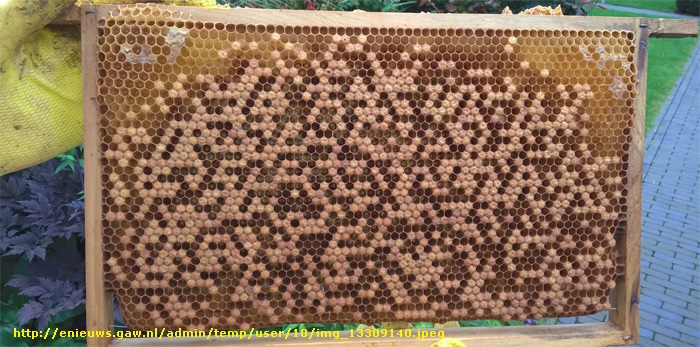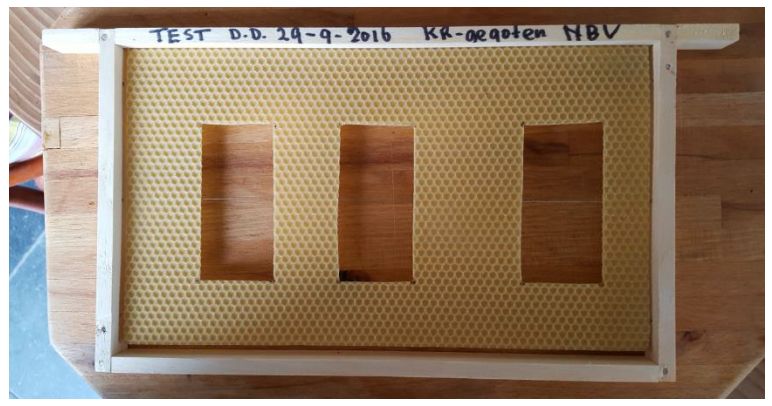ugcheleuce
Field Bee
- Joined
- Apr 15, 2013
- Messages
- 669
- Reaction score
- 1
- Location
- Apeldoorn, Netherlands
- Hive Type
- National
- Number of Hives
- 7-10
Hello everyone
Those who are interested in what happens across the narrow sea may have heard that the Dutch and Belgian beekeepers suffered quite a blow due to bad foundation in 2016.
This foundation was manufactured by a Belgian company who also sold foundation to the Dutch national beekeepers' association's main store. The foundation was "certified", which meant that it was assumed to be free of bee diseases, but... well...
If you saw this in your good colonies, what would you suspect is the problem?

Most beekeepers who had this problem did not initially consider that the fault may lie with their foundation, especially as it was supplied by the Dutch national beekeepers' association (NBV), along with official documentation that it is free of bee diseases. But thanks to internet forums, Dutch beekeepers began to realise by mid-2016 that the fault lay with the foundation.
In the first week of August 2016, the NBV held an online survey during which close to 100 beekeepers submitted evidence and photos. This enabled the NBV to determine the origin of the bad foundation.
By September, samples of the foundation were sent to the Dutch government's food authority for testing. In the same month, the Belgians did the same. The NBV also did tests in which they used foundation from different origins in strong colonies that showed without any doubt that the fault lay with the foundation.
By mid-October the results were in: the foundation contained 20-30% of a mixture of stearin en palmitic acid. The palmitic acid could possibly be explained away if the manufaturer had used the wrong type of soap to separate the sheets from the moulds, but there can be no reasonable explanation for the stearin. Despite the test results, the manufacturer still blames the weather and bad queens for the bad brood pattern experienced by beekeepers in Belgium and the Netherlands.
For this reason, beekeepers who were affected by this (or suspect that they were affected by this) will now participate in another trial that will run during April 2017. The experiment can be done by anyone who is curious about the quality of their foundation, by the way.
In the Netherlands, May is the month in which shook swarms are made and during which lots of foundation is used. So during April (remembering that this is a Dutch April, so it's the start of the cherry flow), cut two or three holes of 5 cm wide and 5 cm apart into a frame with suspect foundation, and hang it in one of your strongest colonies. Within three weeks you should have the answer: whether the brood in natural comb is significantly different from the brood in the foundation.

I suspect many Dutch beekeepers will be applying this test routinely from now one.
Samuel
Those who are interested in what happens across the narrow sea may have heard that the Dutch and Belgian beekeepers suffered quite a blow due to bad foundation in 2016.
This foundation was manufactured by a Belgian company who also sold foundation to the Dutch national beekeepers' association's main store. The foundation was "certified", which meant that it was assumed to be free of bee diseases, but... well...
If you saw this in your good colonies, what would you suspect is the problem?

Most beekeepers who had this problem did not initially consider that the fault may lie with their foundation, especially as it was supplied by the Dutch national beekeepers' association (NBV), along with official documentation that it is free of bee diseases. But thanks to internet forums, Dutch beekeepers began to realise by mid-2016 that the fault lay with the foundation.
In the first week of August 2016, the NBV held an online survey during which close to 100 beekeepers submitted evidence and photos. This enabled the NBV to determine the origin of the bad foundation.
By September, samples of the foundation were sent to the Dutch government's food authority for testing. In the same month, the Belgians did the same. The NBV also did tests in which they used foundation from different origins in strong colonies that showed without any doubt that the fault lay with the foundation.
By mid-October the results were in: the foundation contained 20-30% of a mixture of stearin en palmitic acid. The palmitic acid could possibly be explained away if the manufaturer had used the wrong type of soap to separate the sheets from the moulds, but there can be no reasonable explanation for the stearin. Despite the test results, the manufacturer still blames the weather and bad queens for the bad brood pattern experienced by beekeepers in Belgium and the Netherlands.
For this reason, beekeepers who were affected by this (or suspect that they were affected by this) will now participate in another trial that will run during April 2017. The experiment can be done by anyone who is curious about the quality of their foundation, by the way.
In the Netherlands, May is the month in which shook swarms are made and during which lots of foundation is used. So during April (remembering that this is a Dutch April, so it's the start of the cherry flow), cut two or three holes of 5 cm wide and 5 cm apart into a frame with suspect foundation, and hang it in one of your strongest colonies. Within three weeks you should have the answer: whether the brood in natural comb is significantly different from the brood in the foundation.

I suspect many Dutch beekeepers will be applying this test routinely from now one.
Samuel
Last edited:
















































